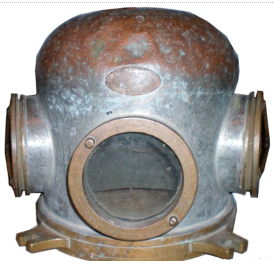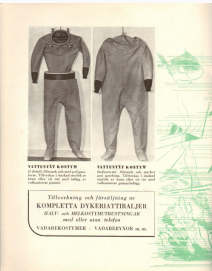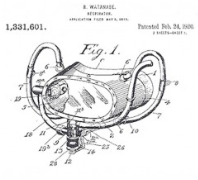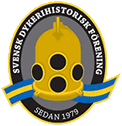In part 5 we deal with the years 1880 – 1915.
(A good source in creating this chronology has been SPUMS Journal Volume 29 No.2 June 1999. Spums Archive
If you have rights to any of the images used to illustrate the material, please contact us via our contact form >, we will give you credit for the image, or remove it if you wish.)
1880-1910 Safety

Additional safety devices were added to diving helmets. These included;
- a valve that regulated the amount of air in the helmet/suit.
- a ”nick valve” that made it possible for the diver to release air from the helmet, which gave some control over the buoyancy.
- A non-return valve that prevented air from going backward, up into the air hose if it should fall off or come loose at a point shallower than the diver.
- a hand-operated valve that allowed the diver to take seawater into his mouth, which he then spat out on the inside of the ”window” to rinse off the mist53.
1889 EW Moir

When the Englishman EW Moir became new superintendent of the construction of the tunnel under the Hudson River, he noted that 25 per cent of the caisson workers was affected by decompression sickness, he built a ”medical lock”, a chamber that allowed slow lowering of pressure when workers were to leave the caisson. He also introduced recompression as a treatment method. The compression meant that the affected person was set in half to 2/3 of the maximum pressure he had been in for 25 – 30 minutes, followed by a decompression of 0.7 bar per minute.
After Moir introduced this, a further 120 cases of decompression sickness occurred, but only two resulted in deaths. Moir did not publish his findings until 1896, and his method quickly became standard in terms of work under pressure. With this method, Moir had initiated what would lead to the effective treatment of decompression sickness 54 .
1893 Louis Boutan

As early as 1871, Frenchman Ernest Bazin describes how to photograph underwater whether or not his concept came into use is not known. Louis Boutan was a French zoologist and fascinated by the underwater world. During a visit to a laboratory in Banyus-sur-Mer, he had to borrow their diving equipment and then began to think about how he could photograph underwater. Together with his brother Austin, he designed an underwater-photography system in 1890 and he is since then counted as the father of underwater photography. In 1898 he published the world’s first book on underwater photography, La Photographie sous-marine et les progrès de la photographie. At the World Exhibition in Paris 1900, among other things, Boutan’s images from the sea were shown 55, 56 .
1894 Buchanan och Gordon

The two Australian inventors Buchanan and Gordon specify a ”deep sea suit”. The drawings are sent to Sieber in London, who is commissioned to manufacture the equipment. The Buchanan-Gordon equipment consists of a copper jacket, with a helmet, sleeves, body part and legs. It is made of coil springs, embedded in a patented material that resists water pressure. Its weight is 178 kg.
According to Buchanan-Gordon, it is a proper arrangement to suit the size of all divers. They also believe that their equipment enables pearl and mushroom divers to work for long periods at depths down to 55 meters and more if needed 57
1900 Leonard Hill

Leonard Hill experimentally demonstrates with a frog as a test animal, that decompression causes bubbles in the blood vessels and that they disappeared during recompression 58 .
Heller, Mager and von Schrotter recommend a linear decompression of 1 atmosphere per 20 minutes in the book ”Luftdruck-Erkrankungen mit besonderer Berücksichtigung der sogenannten Caissonkrankheit” 59 .
1904 Hajen
Sweden was among the first countries in the world to acquire a submarine. Hajen, later renamed Ub no 1, was launched on July 16, 1904. The submarine itself was manufactured under the greatest secrecy at the War Shipyard in Stockholm, while the periscope, which was not included in the original drawings 56 , was produced by Officine Galileo in Florence. The shark was initially powered by a 200 horsepower kerosene engine with ignition balls, which via a generator provided power to an electric motor, which in turn powered the propeller. The generator also charged the batteries, which were used to power the submarine underwater. In a rebuild in 1916, when the hull shape was also changed to improve the surface characteristics of the submarine, the ignition engine was replaced with a diesel engine, thereby relieving the preheating of the ignition balls, which had significantly degraded the atmosphere in the submarine. 60.
Hajen had a length of just under 23.3 meters and a width of 3.6 meters, neither toilet nor heating system was on board. The torpedo tube was 45 centimetres and the submarine carried three torpedoes. Top speed in surface position was 9.5 knots and in dive mode 6.5 knots. The operation time underwater was approximately 13 hours and a maximum dive depth of 30 meters. The shark had room for 8 – 12 people crew 58 . The shark’s first captain was J. Widlund 59 .
There was some concern about how this new type of ship would be seen by the naval officers, but the concern was unjustified. ”Swedish naval officers saw the submarine as a torpedo boat capable of diving” 60 .
The shark was finally disarmed in 1919 and was eliminated in 1922. Nowadays, the submarine is a museum ship and is in an extension to the Marine Museum in Karlskrona.
(Editor’s note. The shark was built not far from the site where the Dyktankhuset was later located.
Unconfirmed data claims that England thought it was ”unsportsmanlike” not to show which nation it belonged to and therefore required submarines to be fitted with mast and national flag.)
1908 JS Haldane, Boycott and Damant

JS Haldane, Boycott and Damant published ”The Prevention of Compressed Air Illness”. The recommended arranged decompression stops. These tables were accepted by the Royal Navy and used for diving down to 61 meters 61 .
1909 Dräger

Dräger begins the career in 1889 as a manufacturer of equipment for the beer industry. The first product was a patented valve that enabled controlled release of carbon dioxide gas for beer taps.
The Roth-Dräger anaesthetic was released in 1902, which for the first time allowed a safe, precise proportion of oxygen and ether during surgery. Dräger also developed a respirator for use in disasters such as mining accidents, called the respiratory protection device 1904/1909. In 1907, the company released the pulse motor, which was the first ventilator ever produced, enabling the pumping of air into the lungs of those in need of resuscitation. This quickly led to the first semi-closed dive system with two oxygen cylinders and a carbon dioxide filter (alkaline cartridge). The diver could stay underwater for up to 40 minutes without air supply from the surface 62 .
1910 Emil Carlsson


Originally, Carlsson continued production of the so-called ”pot” helmets manufactured by Lindqvist, but in 1940 Carlsson published a catalog to celebrate ”30 years in the diving industry” and in this catalog he shows his first 12-bolt helmets.
Carlsson’s ”pot helmets” used to be very common in Scandinavia and were used until 1998. Now they are starting to become rare and prices are going up among collectors.
Shortly after World War II, Carlsson delivered 7 diving equipment to Poland. These helmets had been designed with both a 4-bolt neck ring and a 12-bolt chest plate. These extremely rare helmets have appeared on the market in numbers that exceed the original quantity manufactured. Some research in Poland showed that a group of workshops had been contracted by a Mr Rybicky, the owner of a technical dive company in Gdynia, to build parts for his diving helmets. These parts were mounted in Gdynia and the helmets were sold as genuine antiques by German dealers and a Dutch dealer (they manufactured and sold Emil Carlsson helmets, Draeger helmets, Medi helmets and possibly other models as well). These fake 12 bolt helmets look very authentic and are very hard to recognize as forgeries. Although the original ”pot” helmet has been reproduced, these reproductions were made for the same German and Dutch dealers in the 1990s but they can be recognized for their rough finish.
In 1951 Emil Carlsson retires and his son-in-law Fritiof Morell takes over the company and runs it until his death in 1976. In the summer of 1976, Diving Company Emil Carlsson & Son AB is sold to the dive company Hajen in Uddevalla 63 .
(Editor’s note. A major advantage of Carlsson’s system was the ”half-suit”. The suit was split at the waist and the jacket (top) was sealed against the trousers (bottom) which were fitted with a rigid ring through a lacing with thin hemp rope. a little older and corpulent diver, this was a simpler way to dress than to crawl through the tight neck of the Siebe-Gorman suit.
In conjunction with the stock cleaning at the dive company Hajen in Uddevalla, SDHF gained access to the original mannequins that Carlsson used to glue his semi-suits. These mannequins can now be viewed at Dyktankhuset.)
1915 US Navy

The first US Navy table is published. The table is used for the first time in practical diving the following year when salvaging the submarine F4 from a depth of 92 meters 64 .
1918 Watanabe Riichi

The version that delivered air from the surface to the Ohgushi-regulator was illustrated and described in the Russian Navy Dive Manual of 1945 and was obviously still in use at this time 65 .
References
Please note that many of the references are to Swedish pages or books.
53. Davis RH. Deep Diving and Submarine Operations
Part 1 and 2, 9th edition. Gwent: Siebe Gorman and Co Ltd, 1995
54. William Moir . Visited 20200429.
55. Louis Boutan. Visited 20200511.
56. Encyclopedia of Nineteenth-Century Photography Visited 20200511.
57. Buchanan-Gordon. Visited 20200428.
58. Behnke A. Some early studies of decompression. In The Physiology and Medicine of Diving and Compressed air work. Bennett PB and Elliott DH. Eds. London: Balliere Tindall Cassell, 1969; 226-251.
59. Boycott AE, Damant JCC and Haldane JS. The prevention of compressed air illness. J Hygiene 1908, 8: 342-443.
60. Hajen. Visited 20200428.
61. Granholm Fredrik, (författare) Marinlitteraturföreningen (utgivare) ISBN 9185944408 Publicerad: Stockholm : Marinlitteraturföreningen. 2003
62. Halldin, Gustaf, Från Hajen 1904 till Hajen 1954 : minnesskrift till ubåtsvapnets femtioårsjubileum, Allhems förlag, Malmö, ISBN saknas.
63. Hajen. Visited 20200428.
60. Linderoth. Visited 20200428
61. Hill L and Phillips AE. Deep-Sea Diving. J Royal Naval Med Service 1932; 18 (3): 157-173
62. Dräger. Visited 20200428.
63. Hajen. Visited 20200428.
64. Murin museum. Besökt 20200428.
65. Hill L and Phillips AE. Deep-Sea Diving. J Royal Naval Med Service 1932; 18 (3): 157-173
65. Linderoth. Visited 20200428.
66. Dräger. Visited 20200429
68. Emil Carlsson. Visited 0200429.
69. Schaepfer K. Air embolism following various diagnostic or therapeutic procedures in diseases of the pleura and the lung. John Hopkins Hospital Bulletin, 1922; 33: 321-330
